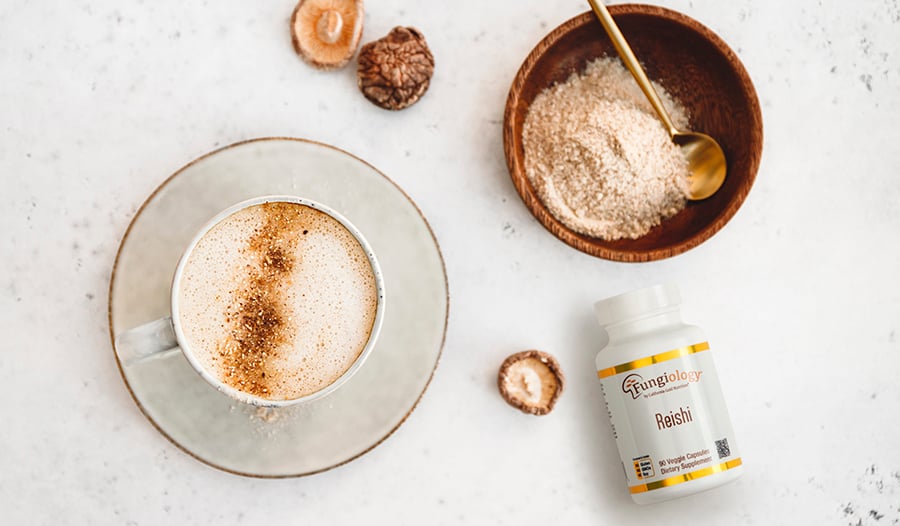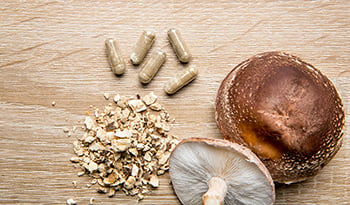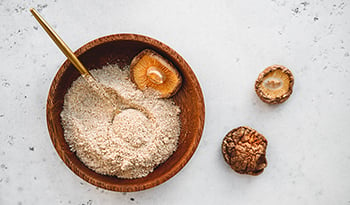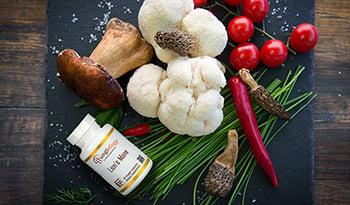Mushroom Supplements: Mood, Focus, Immune Health, And More Benefits
DISCLAIMER:This blog does not intend to provide diagnosis...
- In this article:
- Mushrooms Are A Healthy Diet Staple
- What Are The Benefits Of Mushroom Supplements?
- 5 Types Of Mushrooms And Their Health Benefits
- Mushroom Coffee, Tea, and Cocoa
- Pro Tip: Try Adding One Variety At A Time

Mushroom supplements have been all the rage for the last few years. The use of medicinal mushrooms dates back to old Chinese medical books and Tibetan medicine from thousands of years ago. Although using mushrooms in medicinal ways has been around for so long, their use is just becoming mainstream in the west.
Mushrooms Are A Healthy Diet Staple
Mushrooms that are commonly bought in grocery stores, like portobello, shiitake, button, and white mushrooms all fall into the same category. They are technically fungi, but for cooking purposes, mushrooms are classified as vegetables. Eating mushrooms gives the body a great source of fiber, vitamins, and minerals. One of the most notable nutritional benefits of mushrooms is the number of antioxidants and the soluble fiber beta-glucan, which has been showing to improve heart health.
What Are The Benefits Of Mushroom Supplements?
Mushrooms used in cooking are grown and produced in the same fashion as the kind found in supplements. The difference between the two is mushrooms that are used in supplements are thought to have more health benefits. These benefits classify them as functional foods, meaning they provide more than just nutrition benefits. More than 100 medicinal functions are produced by mushrooms.
The main benefits of mushroom supplements are their antioxidant properties, cardiovascular protection, antibacterial properties, and anti-inflammatory properties. Clinical research on the health benefits of mushrooms is limited, and more research is needed. However, we do know that eating mushrooms is known to be safe and not detrimental to overall health.
Another term you may also hear or see relating to mushroom products is adaptogens. Adaptogens are herbs and mushrooms that help counteract the stress your body undergoes. Pituitary and adrenal glands are involved in stress response and adaptogens may help regulate a stable balance within the body. Adaptogens are another functional benefit of mushroom supplementation.
5 Types Of Mushrooms And Their Health Benefits
Mushroom supplements are made by drying raw mushrooms and extracting them with hot water. After this, they are then turned into a fine powder, like the products we see in stores. When purchasing mushroom supplements, it is important to note that they are not regulated by The United States Food and Drug Administration and to purchase only from trusted sources.
When making supplements a variety of mushrooms can be used based on the medicinal properties they hold. Mushrooms that are used in supplements most often are reishi, lion’s mane, chaga, cordyceps, and turkey tail. There are many more varieties of mushrooms that exist, but these are the ones most commonly found in supplements. Due to the number of varieties available, it can be hard to differentiate which have functional properties and when to use which ones.
Reishi Mushrooms
Reishi mushrooms are scientifically known as Ganoderma lucidum and may also go by lingzhi. In Chinese, the word lingzhi symbolizes divine power and longevity, hence, this variety of mushrooms is believed to be linked to longevity. The taste of reishi mushrooms is bitter and tough in texture. Reishi mushrooms can be found growing on deciduous trees.
Reishi mushrooms are most commonly used to boost the immune system and possibly help fight against free radicals in the body. It’s thought that the beta-glucans in reishi stimulate the immune system, possibly giving them this effect. What makes this mushroom unique is its calming properties from triterpene that can boost moods, reduce anxiety, ease depression, and even improve sleep.
Research in humans is limited, but it is ongoing to determine the potential benefits of reishi mushrooms.
Lion’s Mane
Lions mane mushrooms are one of the most fun-looking mushrooms. They are large white mushrooms that have many long white spines that resemble a lion’s mane. Typically, they are grown on dead and decaying hardwood or can be grown in a substrate at home.
Like most mushrooms, Lion's mane also contains a good amount of antioxidants which can keep cells healthy. Mental clarity is one of the most appealing effects. Some studies have found that lion’s mane has compounds that may stimulate the growth of brain cells. This may not only help with memory but may also support emotional responses and anxiety and depression.
To easily remember what lion’s mane does, try associating a lion’s mane being on the head with the brain being inside your head.
Chaga
Chaga mushrooms are often found growing on birch trees in colder climates. Though the appearance of Chaga mushrooms appears to be a burnt clump of tree bark, they do have functional properties. Traditionally, Chaga was ground and used in herbal teas but can now be found in other supplement forms.
Chaga has been shown to reduce inflammation and oxidative stress in the body which can help reduce the body’s physical signs of aging.
Before trying Chaga mushrooms, it should be discussed with your primary care provider or dietitian. Unlike some other mushroom varieties, Chaga has a protein that can impair blood clotting. Chaga mushrooms are also high in oxalates which have been known to increase the likelihood of kidney stones.
Turkey Tail
Turkey tail, despite its name, contains no turkeys. This name was chosen because the mushroom itself resembles a turkey tail and has bright colors. These can be found growing on tree trunks in wooded areas.
Turkey tail is most popular due to its immune-boosting and antioxidant properties and because it may have compounds that may stimulate and strengthen the immune system.
Cordyceps
Cordyceps encompass more than 400 species, but two types are most often researched and used in supplements.
The most common use for these is for increased energy as they increase the production of a molecule that helps bring energy to muscles. Traditionally cordyceps have been used to reduce fatigue and boost strength and sex drive. Like many other functional mushrooms, they may also slow aging.
Due to the difficulty in harvesting cordyceps, synthetic versions are commonly used.
Mushroom Coffee, Tea, and Cocoa
Mushroom coffee is one of the most common ways to supplement with mushrooms, and is a great herbal alternative to traditional coffee. It can also be called Ganoderma coffee, and often comes in packets that contain mushroom extract and instant coffee. Each packet is added to hot water and mixed to create mushroom coffee. The same process goes for tea and hot cocoa, with the premeasured packet is added to water. Although having mushroom coffee in the morning sounds fancy, it really is just regular black coffee blended with one or more of the functional mushroom extracts.
The mushrooms used in mushroom coffee are dried and extracted to pull out the beneficial compounds and then are blended with regular coffee. Most times mushroom coffee is lower in caffeine than regular coffee, which may be more beneficial for some users. Even with mushroom coffee, the same ideas of limiting the amount of sugar, creamer, and other coffee add-ins being used applies.
Pro Tip: Try Adding One Variety At A Time
When adding any type of mushroom supplements to your diet, try adding one variety at a time so you’re able to track any benefits you may have. Remember that before starting a new supplement, mushrooms included, consult with your medical provider to ensure safety, especially if any pre-existing conditions exist.
Mushrooms for Immunity and Whole Body Health: Read more.
References:
- Panda, A. K., & Swain, K. C. (2011). Traditional uses and medicinal potential of Cordyceps sinensis of Sikkim. Journal of Ayurveda and integrative medicine, 2(1), 9–13. https://doi.org/10.4103/0975-9476.78183
- Valverde, M. E., Hernández-Pérez, T., & Paredes-López, O. (2015). Edible mushrooms: improving human health and promoting quality life. International journal of microbiology, 2015, 376387. https://doi.org/10.1155/2015/376387
- Wachtel-Galor S, Yuen J, Buswell JA, et al. Ganoderma lucidum (Lingzhi or Reishi): A Medicinal Mushroom. In: Benzie IFF, Wachtel-Galor S, editors. Herbal Medicine: Biomolecular and Clinical Aspects. 2nd edition. Boca Raton (FL): CRC Press/Taylor & Francis; 2011. Chapter 9. Available from: https://www.ncbi.nlm.nih.gov/books/NBK92757/
- Lin ZB. Cellular and molecular mechanisms of immuno-modulation by Ganoderma lucidum. J Pharmacol Sci. 2005 Oct;99(2):144-53. doi: 10.1254/jphs.crj05008x. PMID: 16230843.
- Wang SY, Hsu ML, Hsu HC, et al. The anti-tumor effect of Ganoderma lucidum is mediated by cytokines released from activated macrophages and T lymphocytes. Int J Cancer. 1997;70(6):699-705.
- Matsuzaki, H., Shimizu, Y., Iwata, N. et al. Antidepressant-like effects of a water-soluble extract from the culture medium of Ganoderma lucidum mycelia in rats. BMC Complement Altern Med 13, 370 (2013). https://doi.org/10.1186/1472-6882-13-370
- Cui XY, Cui SY, Zhang J, Wang ZJ, Yu B, Sheng ZF, Zhang XQ, Zhang YH. Extract of Ganoderma lucidum prolongs sleep time in rats. J Ethnopharmacol. 2012 Feb 15;139(3):796-800. doi: 10.1016/j.jep.2011.12.020. Epub 2011 Dec 21. PMID: 22207209.
- Lai PL, Naidu M, Sabaratnam V, Wong KH, David RP, Kuppusamy UR, Abdullah N, Malek SN. Neurotrophic properties of the Lion's mane medicinal mushroom, Hericium erinaceus (Higher Basidiomycetes) from Malaysia. Int J Med Mushrooms. 2013;15(6):539-54. doi: 10.1615/intjmedmushr.v15.i6.30. PMID: 24266378.
- Hyun KW, Jeong SC, Lee DH, Park JS, Lee JS. Isolation and characterization of a novel platelet aggregation inhibitory peptide from the medicinal mushroom, Inonotus obliquus. Peptides. 2006 Jun;27(6):1173-8. doi: 10.1016/j.peptides.2005.10.005. Epub 2005 Nov 11. PMID: 16289471.
- Lee, S., Lee, H. Y., Park, Y., Ko, E. J., Ban, T. H., Chung, B. H., Lee, H. S., & Yang, C. W. (2020). Development of End-Stage Renal Disease after Long-Term Ingestion of Chaga Mushroom: Case Report and Review of Literature. Journal of Korean medical science, 35(19), e122. https://doi.org/10.3346/jkms.2020.35.e122
- Hsieh TC., Chao H.H., Chu Y., Doonan B.B., Wu J.M. (2019) Aqueous and Ethanolic Extracts of Medicinal Mushroom Trametes versicolor Interact with DNA: A Novel Genoactive Effect Contributing to Its Antiproliferative Activity in Cancer Cells. In: Agrawal D., Dhanasekaran M. (eds) Medicinal Mushrooms. Springer, Singapore. https://doi.org/10.1007/978-981-13-6382-5_7
- Xu YF. Effect of Polysaccharide from Cordyceps militaris (Ascomycetes) on Physical Fatigue Induced by Forced Swimming. Int J Med Mushrooms. 2016;18(12):1083-1092. doi: 10.1615/IntJMedMushrooms.v18.i12.30. PMID: 28094746.

 By Rhyan Geiger, RDN
By Rhyan Geiger, RDN


